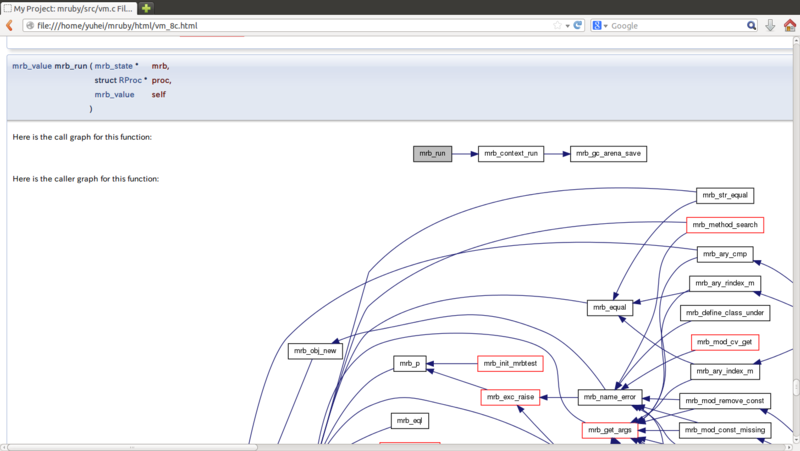Doxygenで関数コールツリーを出力する
以前の記事でC言語のソースコードを解析するためのVim環境を構築した。
C言語のソースコードを解析するため、Vimにプラグインを追加する - .logbook
しかし、大規模なS/Wともなるとエディタだけでは解析に限界がある。そこで今回、ソースコードからドキュメントをリバース・エンジニアリングするためのツール「Doxygen」をインストールすることにした。
Windows版のDoygenであればGUIで設定ができるが、今回はあえてUbuntu上に環境を構築し、コンソールベースで設定することとした。
Doxygenのインストール
毎度お馴染み、apt-getでさくっとインストールする。
$ sudo apt-get install doxygen
今回はC言語のソースコードから関数のコールツリーを出力させたい。そこで、ドキュメント情報をコールツリー等の図表に変換するため、もう一つツールをインストールする。
$ sudo apt-get install graphviz
これでインストールは完了である。
Doxygenの設定(C言語用)
Doxygenの設定を行うためにまずは設定ファイルを生成する必要がある。以下のコマンドで設定ファイルを作成できる。
$ doxygen -g test
コマンドを実行すると、カレントディレクトリにtestという設定ファイルが出来上がっていることがわかる。このファイルをエディタで開く。
$ vi test
下記の通り変更する。
# If the EXTRACT_ALL tag is set to YES doxygen will assume all entities in # documentation are documented, even if no documentation was available. # Private class members and static file members will be hidden unless # the EXTRACT_PRIVATE respectively EXTRACT_STATIC tags are set to YES EXTRACT_ALL = YES ~省略~ # The INPUT tag can be used to specify the files and/or directories that contain # documented source files. You may enter file names like "myfile.cpp" or # directories like "/usr/src/myproject". Separate the files or directories # with spaces. INPUT = "ソース一式のルートディレクトリ" ~省略~ # If the value of the INPUT tag contains directories, you can use the # FILE_PATTERNS tag to specify one or more wildcard pattern (like *.cpp # and *.h) to filter out the source-files in the directories. If left # blank the following patterns are tested: # *.c *.cc *.cxx *.cpp *.c++ *.d *.java *.ii *.ixx *.ipp *.i++ *.inl *.h *.hh # *.hxx *.hpp *.h++ *.idl *.odl *.cs *.php *.php3 *.inc *.m *.mm *.dox *.py # *.f90 *.f *.for *.vhd *.vhdl FILE_PATTERNS = *.c *.h *.cpp # The RECURSIVE tag can be used to turn specify whether or not subdirectories # should be searched for input files as well. Possible values are YES and NO. # If left blank NO is used. RECURSIVE = YES ~省略~ # If you set the HAVE_DOT tag to YES then doxygen will assume the dot tool is # available from the path. This tool is part of Graphviz, a graph visualization # toolkit from AT&T and Lucent Bell Labs. The other options in this section # have no effect if this option is set to NO (the default) HAVE_DOT = YES ~省略~ # If the CALL_GRAPH and HAVE_DOT options are set to YES then # doxygen will generate a call dependency graph for every global function # or class method. Note that enabling this option will significantly increase # the time of a run. So in most cases it will be better to enable call graphs # for selected functions only using the \callgraph command. CALL_GRAPH = YES # If the CALLER_GRAPH and HAVE_DOT tags are set to YES then # doxygen will generate a caller dependency graph for every global function # or class method. Note that enabling this option will significantly increase # the time of a run. So in most cases it will be better to enable caller # graphs for selected functions only using the \callergraph command. CALLER_GRAPH = YES
Doxygenの実行
設定が終わったら仕様書を生成する。ソースの規模に応じて時間がかかる。
$ doxygen test
終わったら、カレントディレクトリに作成されたhtmlフォルダ配下のindex.htmlをブラウザで開く。
$ firefox ./html/index.html
このように関数毎に、「コールされる関数」と「コールする関数」をツリー化した状態で確認できる。
